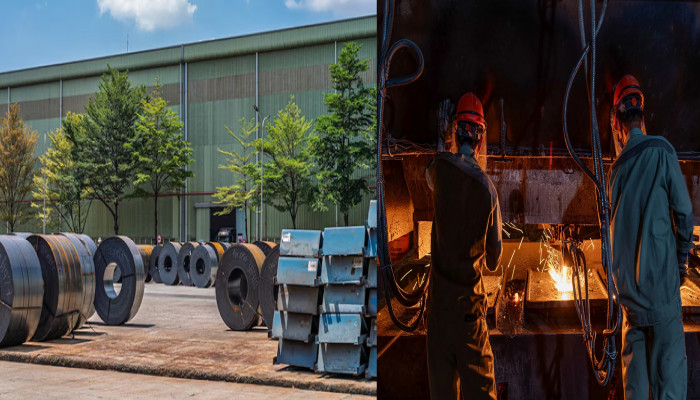Vietnam battles surge of cheap steel imports from China
- In Reports
- 12:35 PM, Apr 23, 2025
- Myind Staff
At the Pomina Flat Steel JSC plant outside of Ho Chi Minh City, it is already 8 a.m. and extremely hot as the final pour of molten metal from the night shift is cooled, moulded, and cut into rods. Later, a long strip is run through a strong press at a Vietnam Steel Corp facility, where it is uncoiled into an acid bath to make it tougher but thinner.
Once completed, these metal batches will be sold in one of the fastest-growing steel markets in the world. According to the Vietnam Steel Association, production could increase by up to 10 per cent this year. Demand for steel could reach 25 million tonnes, which is about a 5 per cent increase from last year. This comes even as China’s much larger steel industry faces issues with oversupply and struggles from a long-lasting property crisis. The rapid economic growth of this Southeast Asian country has greatly benefited companies like Pomina and the state-run giant VNSteel, which operate these two factories. However, like steel producers around the world, they are now facing major shifts in global trade. They are in a tough spot — stuck between growing global resistance to cheap steel and other exports, and strict U.S. tariffs aimed at manufacturing-driven countries like Vietnam.
“We now have to factor in new forces, geopolitical risks that are reshaping global steel chains,” Jiang Li, a veteran analyst at Baoshan Iron & Steel Co., the listed unit of giant China Baowu Steel Group, said at the Kallanish Asia Steel Markets Conference earlier this month. “The world is shifting from decades of globalisation to a more fragmented, deglobalised environment,” Jiang told the gathering in Ho Chi Minh City, where uncertainty dominated nearly every conversation.
Vietnam’s metal industry is growing fast to support the country’s rapid development, including new factories, metro lines, highways, and airports, just like in many parts of Southeast Asia. However, what makes Vietnam different from its neighbours is that it is the biggest buyer of Chinese steel. Since it’s close by and offers a cost-effective market, Chinese steel producers, who are facing slow growth and fewer international buyers, are sending more of their steel to Vietnam. In fact, Vietnam’s steel imports from China reached a record high last year, with a strong boost in the first half of the year. Since 2020, these imports have jumped by nearly 500%.
In February, Vietnam took steps to protect its local steel producers by putting tariffs of up to 28% on hot-rolled coils — a type of steel used in construction and consumer products. Later, it also added another tax of over 37% on galvanised steel imports from China. These tariffs are officially temporary for now, but they might become permanent. As more countries start adding or planning similar tariffs, Bloomberg Intelligence reported earlier this month that about half of China’s steel exports are now affected. This could lead to a drop of up to 14% in China’s steel exports this year.
According to Vu Tran, a former regional head of steel trading at global commodities giant Cargill Inc., the anti-dumping measures against China have made things fairer for Vietnamese producers. “With Chinese producers no longer able to undercut on price, Vietnamese mills now compete well on cost,” he said.
In many parts of the region, this situation is still quite new. Back in 2015-2016, when China was exporting a lot of steel, much of it came to this region, too. But now, countries like Vietnam, Indonesia, and Malaysia have built strong local steel industries and want to protect their own markets. At the same time, global conditions have become much tougher. The U.S., for example, has recently imposed several strict tariffs, including specific ones on steel in March. Other countries have also put up trade barriers to block cheap imports from places like Southeast Asia. When India explained why it wants to introduce protective measures for steel, it pointed to the increasing steel imports from Vietnam, which now exports more steel to India than it imports, and the growing steel production nearby.
According to Le Minh Tu, a director in VNSteel's marketing and planning division, there is "intense" rivalry at home in terms of pricing and market share. Meanwhile, "a global wave of trade protectionism and the US government's unpredictable tariff policies are having a substantial impact on export activities." Hanoi is currently caught up in a wave of diplomatic activity. When US President Donald Trump introduced “reciprocal” tariffs on many countries — later reducing them temporarily to 10 per cent — Vietnam was one of the hardest hit, facing a 46 per cent tariff. In response, Vietnam quickly sent a delegation to Washington for talks. Soon after, Chinese leader Xi Jinping visited Vietnam as part of his regional tour to strengthen ties.
Just a few days later, Vietnam’s Prime Minister Pham Minh Chinh stated that his country shares a “unique bond” with the United States. Hoang Thi Ha, a senior scholar at the ISEAS-Yusof Ishak Institute in Singapore, stated that while China is essential for imports, the US is a major export market for the nation. "Vietnam is the classic example of being torn between two lovers," he added.
"It's something not only Vietnam, but also many other Southeast Asian economies are facing now. The US not only wants to decouple itself from China, but it wants the rest of the world to do so too." Even as the world pays more attention to steel, a metal considered key to industrial growth and national progress, Vietnam’s steel industry is adjusting to the changes. “They have to deal with Trump tariffs, they have to deal with competition with Chinese steel in global markets,” said Vy Nguyen, an analyst at Vietcap Securities JSC.
“There are a lot of difficulties.” Hoa Phat Group JSC, Vietnam's largest steelmaker, is set to launch its new Dung Quat 2 Iron and Steel Production Complex this year. This will add 5.6 million tons of hot-rolled coil to the country's supply every year. Research from CRU Group shows that the new facility will lower Vietnam’s average production costs for this product by 11% in 2025 compared to last year. This will make Vietnamese steel more competitive, helping to protect it from Chinese imports and opening up new export opportunities, even with tariffs in place.
Trump's global tariff policy has increased the number of countries affected by trade barriers, making Vietnam less isolated. “Vietnam is now in a better position than, say, Canada,” said Shankhadeep Mukherjee, an analyst at CRU Group, pointing to Washington’s removal of exemptions for certain countries and a lingering relative advantage. “That means Vietnam can earn wider margins while lowering prices just enough to outcompete Canada.”
At the VNSteel plant, steel sheets are being rolled into thinner, smoother forms — cold-rolled coils used in products like cars and appliances. These coils are stacked in large rolls and are almost ready for shipment, with one already labelled for delivery to Indonesia. As domestic production increases and competition rises, more of these shipments will be heading out, both across the country and abroad.
“Going out and finding new markets or expanding alternative markets is all the more important now that tariffs are spreading — oversupply requires an export market, no matter what,” said Tomas Gutierrez, an analyst at consultancy Kallanish Commodities Ltd. “In the same way we see Chinese traders going out to sell steel, more Vietnamese traders will be going out to explore places like the EU or Latin America.”







Comments